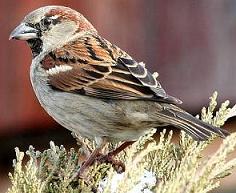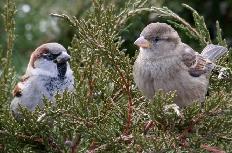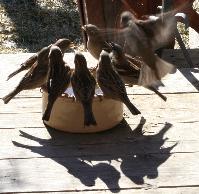House Sparrow

Identification and Pictures
House Sparrow (Passer Domesticus)
 House sparrows are stocky birds with
large heads, and short tails, about 5 3/4 to 6 3/4
inches. Males have a chestnut back, and head, and a black throat.
The cheeks, crown, and under parts are pale
gray. The nape is a chestnut or brown color.
In the summer the bill is blue-black and in the winter
it is brownish.
House sparrows are stocky birds with
large heads, and short tails, about 5 3/4 to 6 3/4
inches. Males have a chestnut back, and head, and a black throat.
The cheeks, crown, and under parts are pale
gray. The nape is a chestnut or brown color.
In the summer the bill is blue-black and in the winter
it is brownish.
 Females, and the young do not have
the black throat, and they are a grayish color below.
Females, and the young do not have
the black throat, and they are a grayish color below.
House sparrows are often seen in large
flocks, which will roost in evergreens or other bushes.
The flocks will often include house
finches, especially in
autumn or winter.
There are many varieties of sparrows.
Most people in North America are familiar with House
sparrows, Song sparrows,
and White-crowned
sparrows. House sparrows were
imported from England in the 1850s. Many people
dislike them because they can take over nesting sites
other song birds might use.
Range and Habitat
House sparrows range across North
America and can be found in cities, farmlands or in the
country, forming into large flocks. They live mostly where
humans live.
It
is estimated that the population is around 150,000,000
birds. The numbers get lower each year.
Breeding and Nesting
House sparrows are usually monogamous
birds.
Males will sit on a
perch outside the nesting site singing their nest-site
call trying to attract the female. If she comes
near he will quiver his wings and call louder. He
will then go in and out of the nest cavity. If she
goes in, the two will probably pair off. Generally
they build
cup-shaped nests in trees, bushes, under eves, and in
other places. The nest is built with grass, twigs,
and leaves, and lined with feathers. Because they tend to take over
bird houses
meant for other birds some people resort to trapping
them in an attempt to get rid of them. Unlike most
birds in the U.S. House sparrows are not protected by
law. They nest in colonies, but both sexes will choose and
defend a small territory. Females lay 5 to 6
speckled or spotted eggs. The spots can be brown,
purple or black. Their eggs are whitish but can be
tinged greenish or blue-gray. The eggs are
incubated for around 10 to 14 days. Both parents
will feed the young which will leave the nest in about 2
weeks. They will stay around the
parents for another 7 to 10 days, and then join flocks of
other young birds. They may have 2 to 3 broods in season.
Song and Call
The chir-up and twittering song of the
House sparrow can be heard all year long. Both
sexes will sing.
House
Sparrow
Food and Feeding
Natural foods for sparrows are insects, seeds,
and berries. They are frequent visitors to
backyard feeders. There will often be more birds then there
is room for, but they are happy to scratch the ground
for seeds falling from the feeders.
 Like
most birds that come to feeders they are also attracted
to water. As shown here, even a dog water dish can
be popular.
Like
most birds that come to feeders they are also attracted
to water. As shown here, even a dog water dish can
be popular.
For more
on food and feeding click here.
For more on feeders click here.
To learn about other
favorite birds click here.
